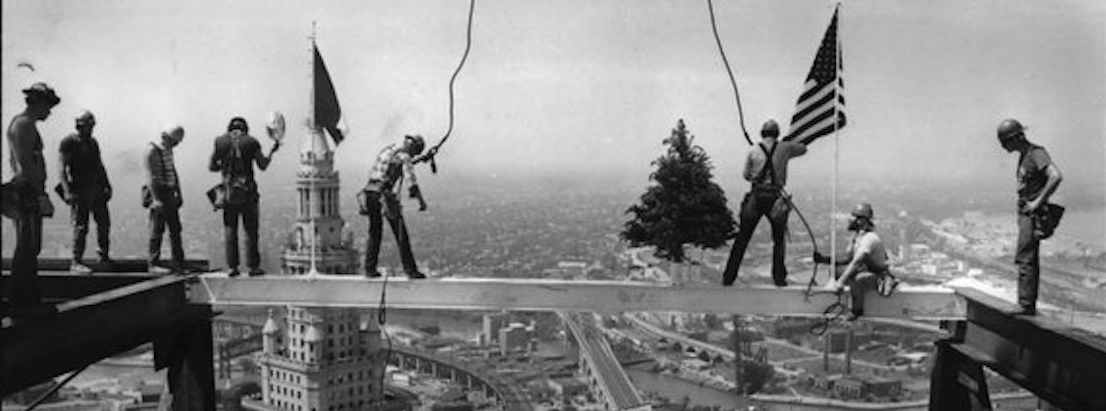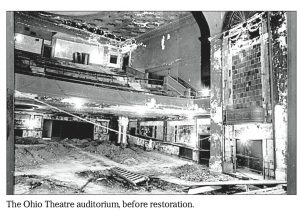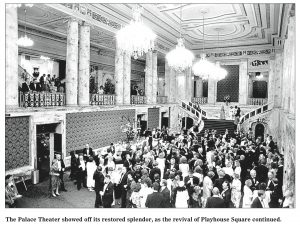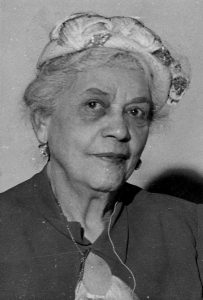
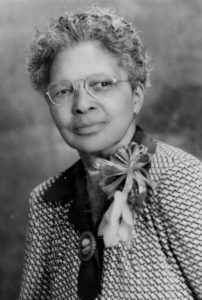
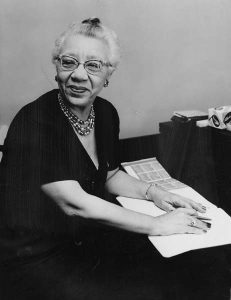
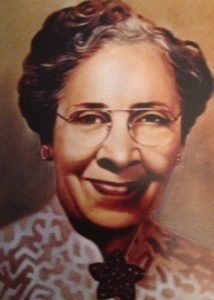
Jane Edna Hunter, Lethia C. Fleming,
Hazel Mountain Walker, L. Pearl Mitchell
Four “Influential Race Women” and their Community
By Marian Morton
In 1939, these “influential race women” were applauded for “their service to the Negro race and its progress”1: Jane Edna Hunter, Lethia C. Fleming, Hazel Mountain Walker, and L. Pearl Mitchell. These ambitious, accomplished women – a social worker, a Republican activist, an educator and actress, and an officer in a local and national civil rights organization – pursued racial progress through institutions and organizations, some black and some racially integrated; through local and national politics, in schools and on stages, through accommodation and confrontation.
At the turn of the twentieth century, Cleveland’s small black population of 5,988 lived in almost all neighborhoods of the city although many blacks lived on the East side. Most remained closer to the bottom than to the top of the economic ladder, but some made small fortunes, and others earned middle-class incomes. By 1930, however, the city’s black population had soared to 71,899,2 swelled by newcomers from the South, fleeing disenfranchisement, rural poverty, and racial segregation enforced by law and by violence. The sheer numbers of this first great migration eroded Cleveland’s “tradition of racial fairness.”3 Clearly defined black neighborhoods developed – most notably the Central area – as blacks were forced, or chose, to live close to one another. Informal exclusion from public and private facilities followed. Compared to other ethnic groups, the economic opportunities of African Americans diminished. Considered unsuited to industry because of their rural background, they were also often excluded from the skilled trades by unions.4
Hunter, Fleming, Walker, and Mitchell watched this enormous influx with dismay and concern. Middle-class by virtue of their education and financial security, these women felt an obligation to help those less fortunate than themselves. The task was enormous: to remedy the history of involuntary servitude in the South and racial prejudice nation-wide, worsened by the trauma of uprooting, the newness of urban life, and growing racial discrimination. Each woman approached this task differently.
“No race of people will do more for you than you are willing to do for yourselves,“5 announced Jane Edna Hunter at a dinner in her honor at the Phillis Wheatley Association (PWA) she had founded two decades earlier. Hunter’s philosophy of black self-help – with significant financial aid from whites – was borrowed from Booker T. Washington, the founder of Tuskegee Institute and the country’s most prominent spokesman for African Americans in the late nineteenth century. Hunter’s autobiography, A Nickel and a Dime, published in 1940, was modeled closely on Washington’s Up from Slavery; both books told the story of the author’s rise from poverty to success with the help of generous white people. Hunter emphasized her own difficulties as an African American woman, recounting her efforts to fend off unwanted advances from men when she worked as a chambermaid and describing the
- 1 Lethia C. Fleming, MSS 3525, container 1, folder 1, Western Reserve Historical Society (WRHS), Cleveland, Ohio.
- 2 Kenneth L. Kusmer. A Ghetto Takes Shape: Black Cleveland, 1870-1930 (Urbana and Chicago. University of Illinois Press, 1978), 10.
- 3 Kusmer, 115.
- 4 Kusmer, 87-89.
- 5 Cleveland Plain Dealer, June 2, 1933: 12.
1
sexual perils she faced when she arrived in the big city of Cleveland. The PWA was intended to address those problems, providing safe, respectable shelter and job training for young African American women.
Hunter, born in 1882 in South Carolina, arrived in Cleveland in 1905, looking for work as a nurse; she had trained at Hampton Institute, a vocational school modeled after Tuskegee. Six years later, she established the Working Girls Association, a boarding home for young, single black women, similar to the whites-only YWCA. The home was renamed the Phillis Wheatley Association after an African American poet, and in 1927, the association moved into an imposing building, designed by the architectural firm of Hubbel and Benes (also the designers for the Cleveland Museum of Art) on Cedar Road in the heart of the Central neighborhood. Hunter cultivated powerful white allies and patrons including Henry A. Sherwin, founder of the Sherwin Williams Company; Elizabeth Scofield, a trustee of both the PWA and YWCA; and soon-to-be congressman, Republican Frances P. Bolton.
Although the PWA flourished, providing classes, clubs and social activities as well as room and board for dozens of young women, Hunter had her critics in the black community. They charged that the PWA endorsed the principle of racial segregation, was controlled by the wealthy whites on its board of trustees, and specialized in training young black women as domestic servants for white families. To those critics, Hunter responded pragmatically: where else would she get the money to maintain an institution that did so much good for her clients? And what other jobs were available to them? Most of Hunter’s black critics eventually came around.
Hunter also had her enemies. Chief among them was African American entrepreneur, Albert D. Boyd, also known as “Starlight,” described by Hunter as the “procurer for wild, wealthy men; later master of the underworld; and finally, manipulator of the Negro vote for unprincipled politicians.”6 Hunter accused Starlight of being a pimp whose saloons and brothels kept the Central neighborhood – also known as “the Roaring Third”– a center of vice and crime. His accomplice, Hunter claimed, was “Timothy Flagman,” whom her readers recognized as Thomas W. Fleming, the first black elected to Cleveland City Council. Hunter mounted a futile campaign to defeat Fleming in 1919.
Out of necessity or conviction, Hunter cultivated good relationships with the white community. But like her role model Washington, she was not uncritical of the racial status quo. In her autobiography, Hunter pointed out the hypocrisy of whites “from society’s leading families” who encouraged vice in the Roaring Third by patronizing its clubs and dives but who barred blacks from their own “respectable white neighborhoods.”7 She also maintained that separate facilities, such as schools, must be equal: “I am … fully convinced that we cannot make real advancement in our pursuit of education … until Boards of Education provide equal educational facilities under the law.”8 Equal, if separate, would also be the position of the National Association for the Advancement of Colored People (NAACP) for another decade.
6 Jane Edna Hunter, A Nickel and A Dime: The Autobiography of Jane Edna Hunter, edited by Rhondda Robinson Thomas (Morgantown, W. Va., West Virginia University Press, 2011), 70.
7 Hunter, 112.
8 Hunter, 153.
2
Like Washington, Hunter achieved enormous popular acclaim – with honorary degrees from half a dozen colleges – but at some cost to herself. A candid admirer described her in 1939: “Friend and foe alike admit/ There’s only one Jane/ Peerless in her realm, to wit/ a gem so rare. They say/ ‘We’ll never see her like again.’”9
In the post-World War II era when dreams of racial integration revived, the racial separatism and accommodationism that Hunter had successfully used to promote her cause, and herself, had become outdated. In 1947, she was forced to retire at age 65 by the Cleveland Welfare Federation, which, as a funder of the PWA, had some control over its direction.
Hunter died in 1971. The Phillis Wheatley Association today provides inexpensive housing and programs for children and the elderly.
Despite Hunter’s open animosity to her husband Thomas W. Fleming, Lethia C. Fleming was a charter member of the PWA and in 1933 organized a dinner honoring Hunter. Perhaps Fleming realized that the PWA was a force for good in her own neighborhood; she lived around the corner on E. 40th St. Or perhaps her long career in politics allowed her to overlook personal slights or philosophical disagreements. Like her husband, she believed that politics were the avenue to success for black people.
Like Hunter, Fleming was a southerner, born in Virginia in 1876 and educated at Morristown College in Morristown, Tennessee. She came to Cleveland in 1912 after her marriage. In 1914, Fleming was one of the few black women to march down the streets of Cleveland in the parade of 10,000 male and female supporters of votes for women. Like most blacks of the first decades of the twentieth century who remembered that the party of Abraham Lincoln had freed the slaves, she was a Republican. Republicans had also elected Clevelander John P. Green to the Ohio House of Representatives in 1881 and in 1892, to the Ohio Senate, its first black member. And Republicans had sent George A. Myers, a powerhouse in Cleveland’s black community, to its national convention in 1892, 1896, and 1900.
Fleming staunchly stood by her husband at his trial for bribery in 1929, testifying on his behalf, and after his indictment, she unsuccessfully asked Ohio Governor George White to pardon him. “A power among the women voters of the Third District and a Republican party leader of recognized ability,”10 she was briefly considered for his vacant seat in City Council. (Clevelanders did not elect an African American woman to City Council until 1949 when Jean Murrell Capers was chosen.)
The concentration of African Americans on Cleveland’s East side – in the ghettos created by the first great migration and racial discrimination – made possible the election of other black councilmen who gained patronage and political clout. Their early victories included the integration of the staff at Cleveland City Hospital.11 In 1934, the three African American councilmen persuaded their white colleagues to pass a resolution condemning the exclusion of blacks from the restaurant in the U.S. Capitol.12
Republican political boss Maurice Maschke, a patron of both Boyd and Fleming, assiduously cultivated the black vote, making public appearances at the PWA and other black
9 Lethia C. Fleming, MSS 3625, container 1, folder 1. 10 Cleveland Plain Dealer, February 11, 1929: 6.
11 Kusmer, 273.
12 Cleveland Call and Post, December 8, 1934: 1.
3
institutions. When he died in 1936, the Cleveland Call and Post gave him credit for “getting the Negroes’ feet placed on the first step of the political ladder.”13
Fleming remained active in Republican women’s organizations and managed the local campaigns for Republican presidential candidates in 1928 and 1936. She stayed loyal to the Republican Party long after most blacks switched their political allegiance to the Democrats during the New Deal. In 1953, she was the only black on the nominating committee of the Republican National Committee.
Described as a “tall woman [of] striking appearance,”14 Fleming was a frequent speaker at civic events, popular with all audiences, white and black, male and female. She supported organizations specifically aimed at blacks: the PWA, the Home for Aged Colored People, and the Negro Welfare League, later the Urban League, which had ties to Washington. But she also belonged to the NAACP, one of whose founders was Washington’s rival, W.E.B. DuBois, which was dedicated first and foremost to racial integration.
Fleming worked for the Division of Child Welfare of Cuyahoga County for twenty years and retired in 1951. Ever the politician, she gave this testimony at her retirement: “I will never forget the loving cooperation in which the two races have worked together in this city.”15 Fleming died in 1963.
Hazel Mountain Walker was less diplomatic than Fleming. When asked in 1954 about the school desegregation case, Brown v. Board of Education, then pending before the U.S. Supreme Court, Walker responded: “Abolishing separate schools without abolishing slums and ghettos will not usher in the millennium. We have no Jim Crow schools in Cleveland, but still this school [George Washington Carver Elementary School, where she was principal], and other schools in the Central Area are nearly 90 percent colored because the residents of the area are more colored than white.”16 Walker made her contribution to her race as an educator, an actress, and an activist for racial integration.
Born in Ohio in 1883, Walker received a bachelor’s degree and in 1909 a master’s degree from Western Reserve University; she also graduated with honors from Cleveland School of Law in 1919 but never practiced law. She became the first black principal in the Cleveland public school system in 1936 and the first to rise directly from the classroom to the principal’s office.
She began her teaching career at Mayflower Elementary School in 1909, earning $45 a month 17 and retired in 1958 as principal of George Washington Carver Elementary School.
That was a challenging half-century for Cleveland public schools. In its crowded classrooms, black children from the American South sat next to the white children of Irish, German, Russian, Italian, and Jewish immigrants. Public school teachers and administrators had to teach all of them how to read, write, add, subtract, and live together. Living together remained Walker’s goal throughout her life.
Walker combined the roles of teacher and actress. She was an early member of the Gilpin Players, a theater group initiated in 1920 and sponsored by Karamu House. Founded in
- 13 Cleveland Call and Post, November 26, 1936: 6.
- 14 Cleveland Plain Dealer, February 10, 1929:8.
- 15 Cleveland Plain Dealer, July 21, 1951: 6.
- 16 Cleveland Call and Post, February 27, 1954: 1D
- 17 Cleveland Plain Dealer, September 1, 1963: 74.
4
1915 as the Playhouse Settlement, Karamu was the creation of Russell and Rowena Jelliffe, who believed that interracial theater would bring interracial understanding. Walker is credited with giving Karamu its name, which in Swahili means “place of joyful meeting.”
She performed at Karamu for more than two decades in plays that revolved around racial themes and plays that did not, in plays that featured Negro dialect and in classical drama. She got rave reviews from the Cleveland Plain Dealer for her performances in Nan Bagby Stephens’ “Roseanne,” a 1930 play by and about blacks, and as the cigarette-smoking Maria in “Porgy,” the play upon which the musical “Porgy and Bess” was based.18 In a 1935 production of “The Soon Bright Day,” Walker’s were the opening lines: “Mornin’ Jesus, and thank yuh Suh for this soon bright day.” The Cleveland Plain Dealer exclaimed that she was “better than she has ever been.” 19
In 1951, in a performance commemorating the 100th anniversary of a woman’s rights convention in Akron, Walker recreated the dramatic speech of the former slave Sojourner Truth, “Ain’t I A Woman?”20 The question was directed to the hostile minister in the audience who maintained that women couldn’t have equal rights because they were weaker than men, to which Truth famously replied: “Look at me! Look at my arm! I have ploughed and planted, and gathered into barns, and no man could head me! And ain’t I a woman? I could work as much and eat as much as a man – when I could get it – and bear the lash as well! And ain’t I a woman?” Walker also performed in Ibsen’s “Ghosts” in 1951 and in 1954 starred in “Member of the Wedding” as Berenice, the cook, counselor, and confidante to the family’s children.
Karamu highlighted the abilities of blacks in a city that had trouble believing in them, and Walker’s performances on Karamu’s stage underscored her own belief that blacks and whites could succeed together.
Walker also pursued interracial progress through politics. She remained active in Republican politics at least through the 1930s. So active in fact that the Cleveland Citizens League complained to the Cleveland School Board in 1932 about her “political activities” while she was teaching at Mayflower Elementary School. 21 The complaints apparently went unheard; Walker continued as precinct leader in the city’s 11th Ward and only three years later, got her path-breaking appointment as principal of Rutherford B. Hayes Elementary School. In 1943, she and L. Pearl Mitchell, “two of Cleveland’s most prominent Negro women,” were appointed to the Cleveland Womanpower Committee, designed to recruit women into war-time industries; “Both women are expected to bring into full focus the problem of integrating Negro women into the city’s many war plants, where, with few exceptions, they have not previously been welcomed.”22
Cleveland’s booming industries during World War II created jobs for a second great migration of blacks to the city. And in the post-war period, Cleveland’s spirit of racial openness revived. City Council, conscious of new black voters, set up a Community Relations Board in 1945 and in 1950 passed fair employment practices legislation.
- 18 Cleveland Plain Dealer, February 3, 1930:1; Cleveland Plain Dealer, March 7, 1933: 5.
- 19 Cleveland Plain Dealer, November 7, 1935: 17.
- 20 Cleveland Plain Dealer, May 24, 1951: 12.
- 21 Cleveland Plain Dealer, June 7, 1932: 11.
- 22 Cleveland Call and Post, February 6, 1943: 1.
5
Walker remained a public advocate for equal opportunity, frequently speaking at conferences and other civic events. She was honored by Karamu for her long years of service and by the Urban League Guild for her work in public education. By the time of her death in 1980, she had become a symbol of African American success in Cleveland, often cited as proof of black capabilities and/or the city’s racial liberalism.
Although she and Walker often worked together, L. Pearl Mitchell was the more vocal critic of Cleveland’s racial status quo, reflecting the growing strength of the city’s black community during the 1930s and 1940s. Known as “Miss NAACP,” she led the charge for racial integration of the city’s public institutions.
Mitchell was born in 1883. Her father, Samuel J. Mitchell, was president of historically black Wilberforce College in Wilberforce, Ohio. She had roots in Cleveland. Her grandfather escaped slavery and settled in Cleveland; her father grew up in Cleveland before attending Wilberforce himself.
Her first public appearances were with the Gilpin Players at Karamu. In 1930, she was vice-president of the group, and Walker was president; both were in the cast of “Porgy” in 1933. Mitchell’s most noteworthy role, however, was in Jo Sinclair’s “The Long Moment,” which opened in 1950 at the Cleveland Playhouse. The plot revolved around a young black musician who was trying to “pass” as white; Mitchell, light-skinned herself, played his mother. The show got good reviews, but more important, it was the first show at the Playhouse with an interracial cast.
Mitchell worked for two decades at the Juvenile Court until the mid-1940s. Her real vocation, however, was the NAACP. Founded in 1909 by blacks and whites, its goal was the racial integration of all aspects of American life. The Cleveland chapter was established in 1914. During the 1920s it successfully challenged the exclusionary policies of stores, theaters, and public facilities and residential segregation in the new suburbs.
Mitchell’s main target was the public school system. In 1932, Mitchell, then vice- president of the Cleveland NAACP, filed a report with the Cleveland school board maintaining that the school district deliberately created racial segregation: forcing black children to attend Central High School when it was not in their neighborhood, discouraging black girls from attending Jane Addams School and black boys from the Cleveland Trade School, and assigning black teachers to black-only schools.23 In 1939, Mitchell argued that the new Central High School should be built east of E. 55th so that its student body would be more “cosmopolitan” – not entirely black. Hunter publicly disagreed24 and won the argument when the school was built on E. 40th, not far from the PWA in the predominantly black Central neighborhood.
In 1935, Mitchell complained that two new public housing projects would foster racial segregation because one project was designated for blacks and one for whites.25 (In 1961, Mitchell pointed out that all public housing projects had become black “ghettos.”26) In 1946, the NAACP opposed the building of Forest City Hospital in the Glenville neighborhood, intended to be a place where black doctors could practice, on the grounds that it would reinforce the
23 Cleveland Plain Dealer, August 8, 1932: 4.
- 24 Cleveland Plain Dealer, September 29, 1938: 8.
- 25 Cleveland Plain Dealer, January 32, 1935: 5.
- 26 Cleveland Call and Post, February 18, 1961: 4A.
6
racial segregation of existing hospitals. The hospital opened in 1957, its staff and patients became predominantly African American, and it closed in 1978.
Mitchell helped to end the racial segregation of children in the Ohio’s Sailors and Soldiers Orphan Home in Xenia, Ohio. As a member of its board of trustees, she took her case to the public and to state officials in 1958. Echoing the 1954 Supreme Court decision, Brown v. Board, which mandated the desegregation of the country’s public school, Mitchell maintained: “It is difficult .. to understand what segregation and separation mean to human souls when you have never experienced it.”27
Mitchell’s other cause was Alpha Kappa Alpha sorority, a social service organization founded in 1908 at Howard University. In 1964, Mitchell persuaded the sorority to donate $440,000 to the NAACP. 28 With federal money and initial guidance from Mitchell, the sorority in 1965 established the Women’s Job Corps Center in Cleveland, intending – as had Jane Edna Hunter 60 years earlier – to provide vocational training for women.
When Mitchell died in 1974, memories of her fierce confrontations with public officials had faded. The Cleveland Plain Dealer described her: “a soft-spoken but courageous, determined leader for social equality for minorities and the poor.”29
All four lived to see the civil rights movement gain strength through the 1950s and early 1960s under the leadership of Dr. Martin Luther King Jr.; they probably heard him speak because he came to Cleveland often. All but Fleming saw the 1967 election of Carl Stokes, the first African American mayor of a big city. In 1976, federal Judge Frank J. Battisti, responding to a brief brought by the NAACP, validated Mitchell’s claim made more than 40 years earlier that the Cleveland School Board intentionally maintained racial segregation in the city’s public schools; he ordered the desegregation of the schools by busing students. Walker lamented that Cleveland’s residential segregation made busing necessary.30
For most of the twentieth century and for most of their lives, Jane Edna Hunter, Lethia C. Fleming, Hazel Mountain Walker, and L. Pearl Mitchell fought the deeply rooted racial inequities of Cleveland. They didn’t win all their battles. But these four “influential race women” did help to create new institutions and organizations and skillfully employed old ones; they enlisted the support of whites and blacks, and perhaps most important, they challenged public officials and private consciences.
- 27 Cleveland Call and Post, July 5, 1958: 7A
- 28 Cleveland Call and Post, August 29, 1964:1A.
29 Cleveland Plain Dealer, September 7, 1974; 2-C.
30 Cleveland Call and Post, October 13, 1979:2-B.
7
